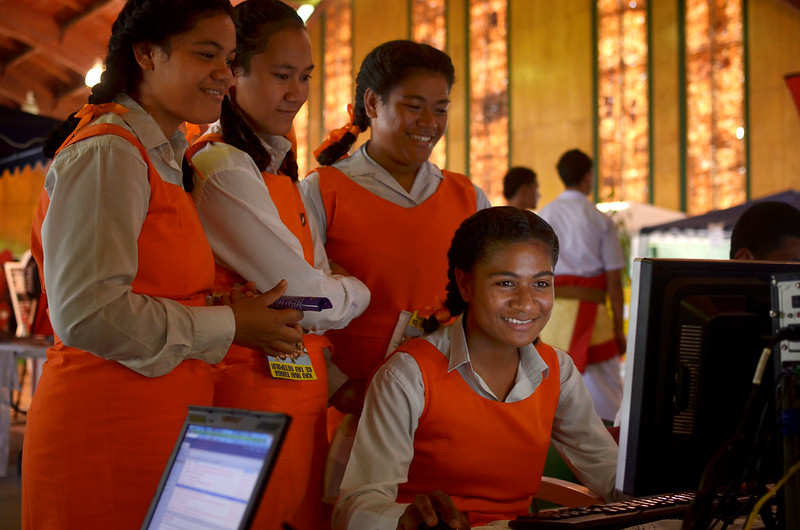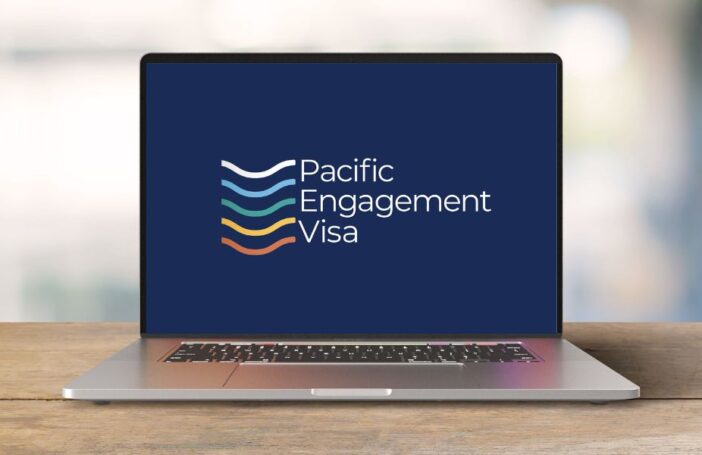Which Pacific countries make the most use of Facebook? And which the least? How does Pacific usage compare to other regions? In which countries do more women than men use Facebook?
We can use Facebook marketing data to answer questions like this, following the code and example (using African data) of a recent World Bank blog. We include every Pacific country we can get data for – dependent and independent – and also Timor-Leste. Facebook use is defined by reference to the number of people who have logged in to Facebook at least once in the last month. We look at data for a month over April-May this year.
There is massive variability in Facebook use in the Pacific (Figure 1). As a percentage of its resident population, Niue’s Facebook use is above 100% because visitors as well as locals use it. Guam, a US territory, has Facebook use of 97%, higher than that of the US itself (84%). American Samoa, Nauru, New Caledonia, the Northern Mariana Islands, Tonga, French Polynesia, and Fiji all sit around 75%. Cook Islands, Marshall Islands, and Samoa are between 61 and 63%. Timor-Leste and Tuvalu are around 50%, Vanuatu and the Federated States of Micronesia about 40%, and Solomon Islands at 27%. PNG has by far the lowest rate of Facebook use at 14%, the 21st lowest in the world (out of 208).
Figure 1: Percentage of population using Facebook
Note: Population data is from World Bank World Development Indicators and Asian Development Bank Key Indicators.
The variation across the Pacific on Facebook use reflects the broader diversity within the region. Both around the world and within the Pacific, income and Facebook use are linked. The Pacific doesn’t stand out as different from the rest of the world except for PNG, which has a much lower Facebook usage than would be predicted by its GDP per capita (Figure 2).
Figure 2: Log GDP per capita vs percentage of population using Facebook
The relationship between Facebook use and internet usage is not as close as might be expected. As Figure 3 shows, the Pacific can be generally divided into two groups: countries with not very high internet usage (around 30%), and countries with high usage (around 75%). The former group has higher Facebook usage than the latter, but there is a lot of variation within each group. For example, Solomon Islands and Marshall Islands are both reported to have 39% and 40% internet usage, but Marshall Islands has 64% Facebook usage and Solomon Islands only 27%. In contrast to Facebook usage, which is an estimation of monthly active users from actual data created by users, internet usage is estimated over a three-month period from ICT household surveys, and in some countries internet usage data has a lag (see the data notes at the end of this post).
Figure 3: Pacific internet connectivity vs percentage of population using Facebook
The Pacific is not a part of the world known for gender equity, but most countries have more women than men on Facebook, or have equal use (15 out of 20). The median ratio for the Pacific of women to total users is 51%, which is 1% above the global median. Despite this overall positive gender picture, there is a lot of variation in the share of women on Facebook. Papua New Guinea (38%), Timor-Leste (44%) and Solomon Islands (46%) have the lowest shares; Tonga, Samoa and Micronesia (54%), and the Northern Mariana Islands (57%), have the highest shares.
Above all, this research points to the diversity of the Pacific — especially when territories are included. The Pacific includes a significant number of not only lower-middle and upper-middle income countries and territories, but also high-income countries and territories. PNG, Timor-Leste, Solomon Islands, Vanuatu, Micronesia, and Samoa are lower-middle income; Fiji, Marshall Islands, American Samoa, Tonga, and Tuvalu are upper-middle income; Nauru, New Caledonia, Guam, French Polynesia, the Northern Mariana Islands, Cook Islands, and Niue are high-income.
With so much diversity in income, and the close link between income and Facebook use, it’s not surprising that we see so much diversity in Facebook use across the Pacific.
Data notes: Facebook marketing data used is accessed for April-May 2024, along with World Bank Development Indicators for population and internet users. The World Bank Development Indicators are mostly updated to 2021, but New Caledonia, Marshall Islands, Guam and French Polynesia only have internet connectivity data from 2017.








In my own understanding of this article, its important to point out countries with bigger land mass and bigger population have lower percentage compared to countries with smaller land mass and small population. If a country has 1 Million Population and 700,000 people use Facebook, their percentage is 70% which is higher than if for example Papua New Guinea at 14%. Thats 1.4Million of 10 Million People on Facebook (Actual Facebook Data).
(i think the 14%) data is drawn using 10 Million Population Figure..)
Thank you for this interesting post and my apologies for the lengthy delay in reading it and commenting.
To my understanding, there is substantial variation with regard to internet pricing in Pacific Island countries. Research monitoring mobile internet prices in Papua New Guinea (PNG) can be found at the following link: https://devpolicy.org/tag/png-mobile-internet-price-research/
I was not surprised to see that men use Facebook more often than women in PNG because Jope Tarai and Michael Kabuni had written about this in 2022. See: https://www.policyforum.net/pngs-digital-divide/
Which figure was used for the PNG population when creating Figure 1? As was pointed out in a comment by Stephen Charteris, the population figure is unclear. Here is a great piece about the PNG population by demographers Michael Bourke and Bryant Allen: https://devpolicy.org/what-is-the-population-of-papua-new-guinea-20210202-1/
See also Maholopa Laveil’s comments in the following news story: https://www.abc.net.au/pacific/programs/pacificbeat/debate-over-un-report-png-population-seventeen-million/101736986
Amanda
Yes Roland, statistics, half truths and damn lies. Classing PNG as a lower middle income country is far from instructive. 75-80 percent of the population are subsistent farmers/fisherfolk. Only a fraction of them live in an area with network coverage or have the means to buy and top up a smart phone. To add a bit more perspective, the population is estimated to be between 10 and 17 million. Nobody actually knows. And 0.35 – 0.4m are in formal employment. Don’t think FB is the big issue.
Very true Facebook is not the big issue! But it is something that there is data available for. Agreed on shortcomings of income class and population data. Improving big issues is first order and improving data can help with that.
Possibly one of the reasons that FB usage in PNG is so low is an indicator of the extreme divergence in income distribution. The rich are very rich where the majority, both rural and urban do not have enough money to buy smart phones. Most rural people have dumb phones, and generally have very little credit on them. The middle class can often afford a cheap smart phone but credit is expensive, even with Digicel’s special FB price.
Indeed it would be interesting to look into the possible factors of PNG’s unexpectedly low use of Facebook. Thank you for mentioning these suggestions, I think you are onto something to see if there is a relationship between inequality and Facebook use – I might look into this. I also like the idea of looking at data prices and special packages. I wonder what other aspects other than internet access impact on people’s Facebook use – maybe peer effects from people around them?